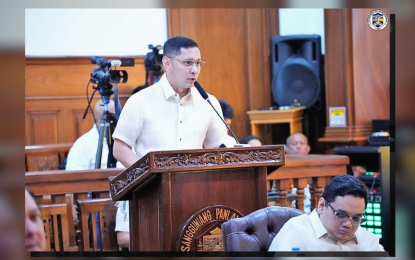LINGAYEN, Pangasinan — The province of Pangasinan will welcome the new year 2024 with the highest hope of attaining real progress and a robust economy as it laid out the foundation of giant leaps in infrastructure, food security, and power supply in the just-concluded year.
This was the prediction made for the New Year by Pangasinan Gov. Ramon Guico III.
“Much of what we’ve done is on planning and funding and laying of legal frameworks to engage in the different modalities of implementing projects,” Governor Guico III said.
Leading these growth-oriented projects is the PHP34-billion joint venture and tollway concession agreements with San Miguel Holdings Corporation (SMHC) for the Pangasinan Link Expressway project Phase 1, signed on Oct. 19, 2023.
The 42.76-kilometer (km) expressway project, which will connect the province’s eastern and western parts, is a game changer, Guico said.
“It will reinvent the transportation and enrich tourism landscape, prioritize accessibility of citizens to major towns and cities, magnify business and livelihood opportunities, multiply economic activities, build more infrastructures, facilitate province-wide travel, and protect our environmental resources in Pangasinan,” he said.
Once completed within the four-year target construction period, the first phase of the expressway is expected to shorten travel time from the Pangasinan-La Union Expressway exit in Binalonan town to Lingayen from 90 minutes to just half an hour or less, he said.
The first phase covers 6.9 km from Binalonan to Manaoag, 11.30 km from Manaoag to Calasiao, and 22.17 km from Calasiao to Lingayen, with a 2.39-km spur road in Calasiao.
Under the agreement, the province will be entitled to a 5 percent share in the toll revenue and commercial development revenues from the start of the concession period.
Bolinao airport
Another project that is underway is the PHP800-million Bolinao Airport. To date, proponents are in the process of land acquisition.
Guico said the airport will have a 1,500-meter runway that is large enough to accommodate propeller-type commercial aircrafts, like Airbus a320.
"Phase Two will expand to 2.5 kilometers the taxiway for smaller aircraft, ramp, apron, and terminal as well as the roads going to the main road that needs development," he said.
Funding will come partly from the provincial government and a loan from state-owned Land Bank of the Philippines.
To further encourage more infrastructure investments in the province, Guico said they plan to file the Joint Venture for Innovative Start-Up Ordinance measure.
“We’re proposing another type of Private Public Partnership (PPP) and Joint Venture (JV) code for innovative start-ups. This way we can involve a lot of private corporations and firms to help us develop a lot of our infrastructure projects and services as well,” he said.
Guico said existing PPP and JV codes are strict and somehow prohibit smaller corporations from joining since these require a minimum of five-year good financial status and high capitalization.
“But there are smaller corporations that have the fund and are on the same page as the province and some of them are our kababayans (province mates) who want to help,” he said.
Guico said a build, lift, and transfer scheme will be implemented through a joint venture with start-ups.
“Di natin kailangan umutang. Ito ‘yung gusto namin project, turn over mo sa amin. We pay them monthly and then over the course of years turnover na sa atin (We don’t have to take out a loan. We will tell them: This is the project that we want and then turn it over to us. We will pay them monthly and over the course of years, the project will be turned over to us),” he said.
Among the projects that could be under the JV agreement are hospitals and classroom buildings as well as iconic buildings that will boost tourism and economic enterprises, he said.
Guico said the province welcomes investors that have signified intentions to build ports and economic zones and to create 100,000 jobs.
Renewable energy
By 2025, the provincial government eyes to produce 1.5 gigawatts of solar power capacity from the five renewable energy companies that are set to construct solar farms in the next few years.
This year, the Sangguniang Panlalawigan (Provincial Council) approved the permits of Sinocalan Solar Power Corporation, for its 60-megawatt (MW) solar power project in Barangay Sto. Domingo, San Manuel; Renovable Earth Corporation, for the development and operation of 75.014MW peak (MWp) and 49.500 MW alternating power (ac) project in the villages of Pangascasan and Capantolan in Sual; and PV Sinag Power Inc., for the development and operation of 75 MWac and 146 gigawatt hour (GWh) generation capacity of Cayanga-Bugallon Solar Power Project in Barangay Cayanga, Bugallon.
PV Sinag Power Inc. proposed the development and operation of 128 MWac and 254 GWh generation capacity of Laoag-Aguilar solar project in Barangay Laoag, Aguilar; and 3 Barracuda Energy Corporation, for the development of a solar energy plant that have up to 650 MWp with an attached energy storage plant of up to 200 MW. (With a report from PNA)
=--
Photo caption
SOLAR POWER. Pangasinan Acting Governor Mark Ronald Lambino delivers a speech on the joint venture agreement between the provincial government and the San Miguel Holdings Corporation during the Sangguniang Panlalawigan session last May 8, 2023. Lambino, in an interview Thursday (Oct. 5), said the province eyes to produce 1.5 gigawatts of solar power by 2025. (Photo courtesy of Province of Pangasinan Facebook page)
#OpinYonSubic #Pangasinan #PangasinanSeesBannerYearIn2024 #OpinYon #WeTakeAStand
